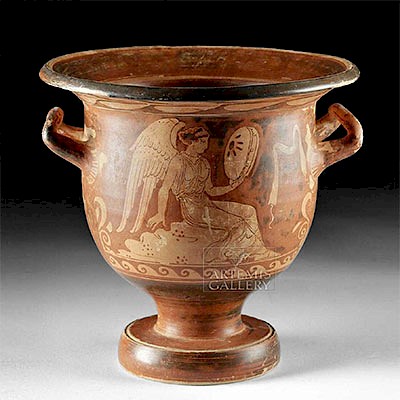19th C. Russian Icon - Dormition of the Virgin
Lot 285
About Seller
Artemis Gallery
686 S Taylor Ave, Ste 106
Louisville, CO 80027
United States
Selling antiquities, ancient and ethnographic art online since 1993, Artemis Gallery specializes in Classical Antiquities (Egyptian, Greek, Roman, Near Eastern), Asian, Pre-Columbian, African / Tribal / Oceanographic art. Our extensive inventory includes pottery, stone, metal, wood, glass and textil...Read more
Estimate:
$1,500 - $2,500
Absentee vs Live bid
Two ways to bid:
- Leave a max absentee bid and the platform will bid on your behalf up to your maximum bid during the live auction.
- Bid live during the auction and your bids will be submitted real-time to the auctioneer.
Bid Increments
| Price | Bid Increment |
|---|---|
| $0 | $25 |
| $300 | $50 |
| $1,000 | $100 |
| $2,000 | $250 |
| $5,000 | $500 |
| $10,000 | $1,000 |
| $20,000 | $2,500 |
| $50,000 | $5,000 |
| $100,000 | $10,000 |
| $200,000 | $20,000 |
About Auction
By Artemis Gallery
Mar 7, 2019
Set Reminder
2019-03-07 10:00:00
2019-03-07 10:00:00
America/New_York
Bidsquare
Bidsquare : VARIETY SALE | Antiquities & Ethnographic Art
https://www.bidsquare.com/auctions/artemis-gallery/variety-sale-antiquities-ethnographic-art-3928
Around the world & back in time - be amazed at the treasures you will find. Antiquities from Egypt, Greece, Italy and the Near East, Asian, Pre-Columbian, African / Tribal / Oceanic, Native American, Spanish Colonial, Russian Icons, Fine Art, much more! Artemis Gallery info@artemisgallery.com
Around the world & back in time - be amazed at the treasures you will find. Antiquities from Egypt, Greece, Italy and the Near East, Asian, Pre-Columbian, African / Tribal / Oceanic, Native American, Spanish Colonial, Russian Icons, Fine Art, much more! Artemis Gallery info@artemisgallery.com
- Lot Description
Eastern Europe, Russia, ca. 19th century CE. A touching rendition of the Dormition of the Virgin showing the Holy Theotokos on her deathbed surrounded by mourning Apostles, Church Fathers, and pious women in egg tempera and gold leaf on wood. Christ has descended from heaven surrounded by angels, looking at and pointing to his mother as he holds a small swaddled child who represents the soul of the Virgin Mary. In front of her deathbed, the Archangel Gabriel raises his sword to cut off the hands of the impious priest who wishes to upend the bier. Size: 11.25" W x 13.75" H (28.6 cm x 34.9 cm)
Donning garments of jewel tone red and blue and golden highlights that radiate hallowed golden rays, Jesus is presented in divine glory. The apostles are depicted standing in two clusters before architectural interiors of columniated arches which most likely metaphorically represent Mary's house and the Temple of Jerusalem (the destination of the procession), the apostles depicted in Byzantine fashion with their dramatic postures and gestures directing our attention toward Mary. The Dormition of the Virgin is among the most important feast days of the Eastern Orthodox Church. Commemorating the Virgin’s death or “falling asleep” and her resurrection prior to being taken to heaven, it is celebrated on August 15th. This is a fine example of the icon of the feast.
The story behind this iconography is as follows. On one of the many occasions when the Virgin was praying at Golgotha, the Archangel Gabriel appeared to her and announced that her demise from this life to eternal life was fast approaching, and the Virgin prayed that the Lord would have the apostles come see her again and prepared for her deathbed. Then the apostles were carried miraculously from their locales of preaching to Jerusalem where they gathered together to mourn with Christ appearing behind the coffin carrying his mother’s soul. In the words of Theodore the Studite, “ You fell asleep, yes, but not to die. You were assumed into heaven, but you never cease to protect humanity.” (Alfredo Tradigo, “Icons and Saints of the Eastern Orthodox Church” The Getty Museum (2004) p. 153)
Icons (icon means "image" in Greek) are sacred objects within the Eastern Orthodox Christian tradition. Found in homes as well as churches, these painted images depict holy persons and saints as well as illustrate scenes from the Scriptures. Icons are not worshiped, but are instead venerated for their ability to focus the power of an individual's prayer to God. As such they are truly "windows into heaven."
Provenance: ex-Francis & Lilly Robicsek Collection, Charlotte, North Carolina USA
All items legal to buy/sell under U.S. Statute covering cultural patrimony Code 2600, CHAPTER 14, and are guaranteed to be as described or your money back.
A Certificate of Authenticity will accompany all winning bids.
We ship worldwide and handle all shipping in-house for your convenience.
#119535Surface wear and losses as shown. Verso shows age cracks and losses. With some restoration, this icon would be a striking addition to any collection; priced under value to make that possible.Condition
- Shipping Info
-
All shipping is handled in-house for your convenience. Your invoice from Artemis Gallery will include shipping calculation instructions. If in doubt, please inquire BEFORE bidding for estimated shipping costs for individual items.
-
- Buyer's Premium



 EUR
EUR CAD
CAD AUD
AUD GBP
GBP MXN
MXN HKD
HKD CNY
CNY MYR
MYR SEK
SEK SGD
SGD CHF
CHF THB
THB

















